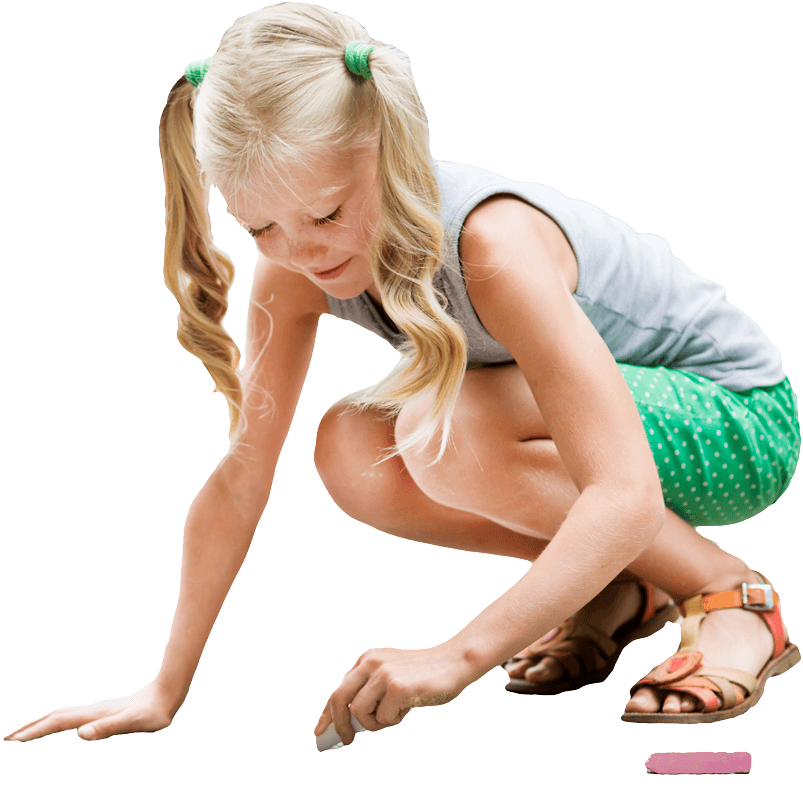Chalk Activities
SHAPE America National Standards
3, 5
SEL Competency:
Self- management
- Stress management
- Self-discipline

Outcomes:
- Using sidewalk chalk, I can create a new activity that makes me move.
- I can create positive messages on a sidewalk near me.
- I can use my body as a way to relax.
Equipment Needed:
Sidewalk Chalk
Teaching Hints:
Kids know what to do with chalk. Encourage them to be creative and find new ways to be active.
Games and Activities with Chalk:
Tic-Tac-Toe Relay: Draw a Tic Tac Toe board and have students line up on opposite sides of the board 15’-20’ away. Students must race to write either an X or an O on the board. After they take their turn, they must run back to the beginning marker and back before taking their next turn.
Movement Maze: Encourage students to get creative by drawing a movement maze. Kids can draw different patterns to walk along, circles to jump between, or specific activities (squats, push-ups, jumping jacks) to perform while following the maze. Class option: have students each draw a section of a maze. After everyone is finished, go through the entire large maze together. Draw the maze in a commonly trafficked area to increase activity throughout the entire school.
Target Practice: Draw a target bull’s-eye with numbers in each spot for scoring. Use the beanbag to score points. Complete with partners or a class to see who can score the most points.
Broad Jump: Draw a starting line on the sidewalk and additional lines at every foot. Have students test their jumping skills. Challenge students with different types of jumps (jumping off two feet, jumping off of one foot and landing on two, walking into a jump, running long jump – be careful on the sidewalk with this)
Write Encouraging Messages: In commonly trafficked areas, have students write words of encouragement around the school. Some examples include, “Have a Great Day”, “You Are Special”, “WE love who YOU are!”
Hopscotch: Challenge students with a hopscotch course.
Spelling Challenge: Work on spelling skills with this challenge. Write out all of the letters of the alphabet on the sidewalk. Call out a word from your weekly spelling list and have students hop to each letter in the word. Add variety by switching up the types of locomotor movements.
4-Square: Draw a 4-Square court and encourage students to play with a playground ball.
Follow the Line: Students can draw a squiggly line throughout the play area going anywhere. It should be roughly 30’-50’L. Once finished, have students perform different locomotor movements along their line (hopping, skipping, jumping, galloping, etc.…)
Create a Sentence: Have a student write a bunch of words scrambled throughout a small area. These words should include a variety of nouns, verbs, adjectives, and pronouns. Once complete, have students create a sentence by hopping to each word. How many unique sentences can you create?
Scavenger Hunt: Create a scavenger hunt in your play area. For example, at start you may say, “Run to the basketball hoop”. At the basketball hoop you could say, “Complete 15 Jumping Jacks and move 10 paces forward.” Encourage students to be creative and challenge their classmates.
Math Jumping Challenge: Write out numbers 1-10 on the sidewalk. Call out the answer to a math problem and they have to hop to numbers that add up to your answers. For example, using addition, call out the number 13. A student could jump to 9 and 4. If you call out “Multiplication 48” A student could jump to 6 and 8.

Communicate and connect the SEL competency of self-awareness along with its sub-competencies by explaining to students that part of being self-aware is being able to identify your emotions. A lot of times our decisions can be related to our emotions. The better we get at recognizing our emotions, the better we will get at making healthier decisions.
Feelings Finder: Have students identify different kinds of feelings and write them throughout a small area. Have students frog jump from feelings they have felt today. Then have them jump from feelings they have felt over the last couple of days. And lastly, have students jump from feelings they have felt at some point in their entire life. Reinforce to students that all feelings are healthy and normal even feelings like anger or being sad. Have students identify healthy ways to help improve their mood.
Mindful Drawing: Draw a simple picture. As you are drawing, pay attention to things you might not normally notice. How does the chalk feel in your hand? How does the chalk sound against the ground as you draw? Does the chalk have a smell? What else do you notice about the chalk as you draw? Paying close attention like this is a form of being mindful. Being mindful is slowing down and paying full attention, you are focused, relaxed and in the present moment. Mindful drawing or coloring is a great way to tool to use when a person might need a moment to clear their mind when feeling a strong emotion.
National Standards & Grade-Level Outcomes for K-12 Physical Education is used under license from SHAPE America. © SHAPE America 2014, www.shapeamerica.org. All Rights Reserved.